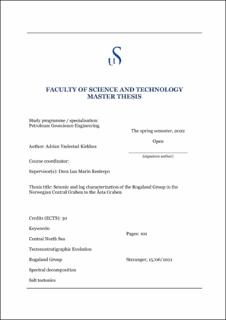| dc.description.abstract | With the rapid transformation in the energy sector, near field exploration is becoming a large priority. Although, the Paleocene Rogaland Group has been a successful target in different areas of the Norwegian Continental Shelf, these sandstones remain underexplored. Recent advancement in technology have caused an increased interest in the Rogaland Group. Thus, the main motivation of this thesis is to improve the understanding about the lateral and vertical variation of the Rogaland Group, and how the tectonics and halokinesis influenced the deposition of the sediments. This was done utilizing 2D and 3D seismic data, combined with the well logs. The study area is located approximately 200 km south-west from Stavanger and covers structural elements such as the Åsta Graben, Sørvestlandet High, Feda Graben, and the Breiflabb Basin.
Different seismic facies were interpreted based on a combination of well logs characteristics, seismic interpretation (i.e. strata geometry, strata termination) and attribute generation. The lithology of the Rogaland Group consists of a variety of fine and coarse lithologies, ranging from very coarse sand to shale in the different seismic units. The Rogaland group was divided into 3 seismic units: Seismic unit 1 (Rogaland Group Base to Maureen/Våle Formation); Seismic unit 2 (Vidar Formation to Lista Formation) and Seismic unit 3 (Sele Formation to the Balder Formation/Rogaland Group Top). Seismic unit 1 is characterized by a deep marine environment and were controlled by local salt movement, causing locally sourced fans. More regionally sourced submarine fans were also observed. Seismic unit 2 is characterized by deep marine environment under low energy conditions. Salt movement at the time caused fan structures and mass transport complex to be developed over the area, and the occurrence of a regionally sourced fan from the UK is also detected. Seismic unit 3 is characterized by a deep marine fan system, with the appearance of submarine channels and radial faults over the growing salt diapirs. Injectites, mass flow deposition in turbiditic currents, channels and submarine fans all unraveled from different attribute generation and log examination.
A model of the play elements has been proposed based on the seismic and log observations where sand with good to excellent reservoir qualities are located. The seal identified consists of finer surrounding lithologies around the sand prone sediments. Additionally, an area where the Rogaland Group could be suitable for CO2 injection have been suggested in the Fiskebank Formation towards the East where the reservoir is around 1300m, and lithology is sandstone dominated. | |
